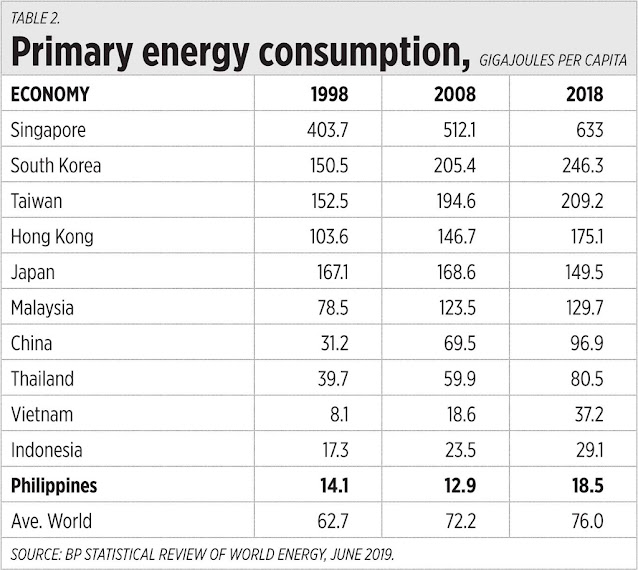* My article in BusinessWorld on September 4, 2019.
See also:
Among the topics discussed during the Heartland
Institute’s 13th International Conference on Climate Change (ICCC-13) that I
attended on July 25 in Washington, DC, USA, was the social cost of carbon (SCC)
vs social benefit of carbon (SBC).
Among the speakers was Dr. Kevin Dayaratna, Senior
Statistician and Research Programmer of the Heritage Foundation’s Center for
Data Analysis.
Kevin discussed the “Cost-Benefit Analysis of the Green
New Deal.” The Obama administration proposed the Social Cost of Carbon (SCC)
for regulation, defined as “the economic damages per MT of CO2 emission.”
Kevin wondered how does one actually estimate the SCC and
what really is the long-term economic impact of CO2 emissions across a
particular time horizon. He mentioned three statistical models (IAMs) to
estimate SCC: the DICE model, the FUND model, and the PAGE model.
Heritage altered the assumptions made by the Obama
administration, they ran two of the three models, the results show that SCC can
drop by 40-200%, can even be negative at times, under very reasonable
assumptions. Negative “social cost” means social benefits. Like the greening of
the planet, 1982-2009.
Kevin concluded that for the newly proposed Green New
Deal (GND) in the US, instituting carbon capture regulations by 2040 will
result in income loss of more than $160,000 for a family of four, increase in
household electricity expenditures of up to 30%, and an aggregate $15 trillion
loss in GDP. Thus, the GND should be junked, using the SCC for cost-benefit
analysis should be junked.
Another speaker, Dr. Roger Bezdek, Founder and President,
MISI, a DC-based economic, energy and environmental research firm, noted that:
1.) Fossil fuels and CO2 are demonized and blamed for everything but they are
essential to modern life and will remain so in the future. 2. To reduce 2050
GHGs to 80-95% of 1990 levels implies that 2050 living standards in the world
would be reduced to levels of 1800s; 3.) Benefit-cost ratios are very high and
will remain orders of magnitude larger than any reasonable SCC estimates; and,
4.) The social benefits of carbon (SCB) and fossil fuels outweigh costs by
orders of magnitude and will continue to do so.
Dr. Craig Idso, founder and former President of the
Center for the Study of Carbon Dioxide and Global Change, lead author of
“Climate Change Reconsidered” series produced by the Non-governmental
International Panel on Climate Change (NIPCC), argued that more CO2 emissions
and fossil energy have improved human prosperity and benefit the human and natural
world. Atmospheric CO2 is the basic food of plants, their primary raw material
to construct their tissues and, aided by sunlight, produce their own food via
photosynthesis. Thousands of laboratory and field experiments have shown that
higher CO2 concentrations increase plant productivity and growth. Which means
more trees, more crops, more food production. More, not less, fossil energy is
needed to enhance the future of human environment.
He computed “total human life-years” until around 2017, I
updated his computation to 2019 and expanded it to 2050. Data from the UN DESA
and geoba.se/population. (See Table 1.)
From 1820 to 2019 or nearly 200 years, there was 17.4x
expansion as humans live longer and healthier, mainly because humanity used
fossil fuels to modernize their food production, transportation of goods and
people, modern electricity that run 24/7 and so on. Projecting to 2050, there
would be 24.3x over 1820 and 1.4x over 2019 levels.
The Philippines should never toy with the idea of following
GND-type of energy policies. Currently, the per capita energy consumption of
Filipinos on average is among the lowest in East Asia, only 18.5 gigajoule per
person in 2018 — just one-half the consumption of an average Vietnamese and
nearly one-fifth (1/5) of the global average. A gigajoule is equivalent to
277.8 kWh. (See Table 2.)
Last week, my friend and fellow BusinessWorld columnist
Andrew Masigan invited me to a presentation by Trevor Neilson of i(x)
investments, about the economics and technology of converting solid waste into
aviation fuel or diesel. We often hear of biomass energy, converting
agro-forest and household solid wastes into electricity, it is old technology
but this one is new — solid wastes to aviation fuel. A summary of the economics
and business prospects of this business innovation is found in Table 3.
It is a good initiative. Very costly investments but high
potentials for the Philippines, singled out by the US business proponents
because of its high solid waste production and geographical location — just two
to four hours by plane to major business centers in the region,
north-west-south of Manila.
---------------See also:




No comments:
Post a Comment